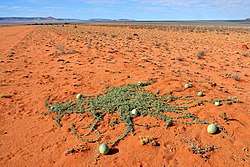Citrullus ecirrhosus
Citrullus ecirrhosus, commonly known as Namib tsamma, is a species of perennial desert vine in the gourd family, Cucurbitaceae, and a relative of the widely consumed watermelon (Citrullus lanatus). It can be found in both Namibia and South Africa, in particular the Namib Desert. It is the sister species to the bitter melon, Citrullus amarus with which it shares hard, white and bitter flesh.[2]
| Citrullus ecirrhosus | |
|---|---|
| Scientific classification | |
| Kingdom: | Plantae |
| Clade: | Tracheophytes |
| Clade: | Angiosperms |
| Clade: | Eudicots |
| Clade: | Rosids |
| Order: | Cucurbitales |
| Family: | Cucurbitaceae |
| Genus: | Citrullus |
| Species: | C. ecirrhosus |
| Binomial name | |
| Citrullus ecirrhosus Cogniaux 1888 | |
| Synonyms[1] | |
| |
The vines can crawl for up to two meters, and it has yellow flowers. As a desert plant, it is a hardy species, surviving with little water and strong sunlight. The leaves form annual stems which die back each year. The plant relies on water deep in the ground and morning fogs. It is an important source of water for numerous desert fauna. The bitter-tasting fruit it produces are known as tsamma melons.

References
- "The Plant List: A Working List of All Plant Species". Retrieved 8 October 2014.
- Chomicki, G., and S. S. Renner (2015). "Watermelon origin solved with molecular phylogenetics including Linnaean material: another example of museomics". New Phytologist. 205 (2): 526–532. doi:10.1111/nph.13163. PMID 25358433.CS1 maint: uses authors parameter (link)
